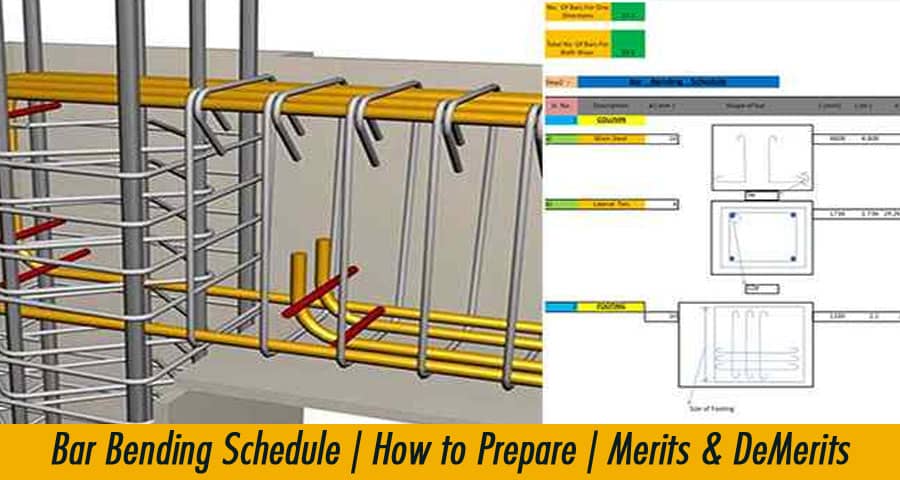What is a Bar Bending Schedule | How to Prepare | Merits & DeMerits

Construction is a complex and precise industry that demands careful planning and execution. A vital aspect of any construction project is ensuring the structural integrity of the building. One of the tools that plays a crucial role in this process is the Bar Bending Schedule (BBS).
Understanding the Bar Bending Schedule
A Bar Bending Schedule is a document that provides detailed information about the reinforcement steel required in a construction project. It includes data about the bar shapes, sizes, and their placement within the structure. The BBS acts as a guideline for contractors, engineers, and laborers, ensuring that the reinforcement steel is placed accurately.
Importance of Bar Bending Schedule
The importance of a Bar Bending Schedule cannot be overstated. It ensures the quality and stability of a structure by guiding the correct placement of reinforcement bars. Without a BBS, construction may lack precision and could lead to structural weaknesses, increasing the risk of accidents.
How to Prepare a Bar Bending Schedule
- Initial Data Collection: The first step in preparing a Bar Bending Schedule is gathering all the necessary data. This includes the structural drawings, specifications, and design requirements for the project.
- Determining Bar Sizes and Shapes: Based on the project's design, the next step is to determine the sizes and shapes of the reinforcement bars required. This is a critical aspect of the BBS, as it directly impacts the structural integrity of the building.
- Creating the Bar Bending Schedule: Once all data is collected and the bar sizes and shapes are determined, the BBS is created. It is essential to use standardized symbols and conventions for clarity and consistency.
Merits of Using a Bar Bending Schedule
- Ensures Structural Integrity: The primary merit of using a Bar Bending Schedule is that it guarantees the structural integrity of the building. Properly placed reinforcement bars prevent cracks, deformation, and ensure the building's longevity.
- Cost Efficiency: While preparing a BBS may initially seem like an added cost, it actually leads to cost efficiency in the long run. Accurate placement of bars reduces material wastage and minimizes rework.
- Time-Saving: Using a BBS streamlines the construction process, saving time and improving efficiency. Contractors can work more swiftly with precise guidelines.
Demerits of Using a Bar Bending Schedule
- Initial Time and Cost Investment: Preparing a BBS requires time and resources. This initial investment can be a drawback for small projects with limited budgets.
- Modifications and Updates: If there are design changes or modifications during construction, the BBS may need to be revised. This can be a time-consuming process.
- Skilled Workforce Required: Interpreting and implementing a BBS demands skilled labor. Inexperienced workers may struggle with understanding and following the schedule accurately.
Common Mistakes to Avoid in Bar Bending Schedules
To ensure the effectiveness of a BBS, it's crucial to avoid common mistakes such as incorrect data input, improper bar placement, or using outdated design standards.
Bar Bending Schedule Software
In the digital age, specialized software is available to create and manage BBS, making the process more efficient and reducing the margin of error.
The Future of Bar Bending Schedules
As construction technology advances, BBS is likely to become even more precise and integrated into Building Information Modeling (BIM) systems, further improving construction quality.
Conclusion
A Bar Bending Schedule is an indispensable tool for ensuring the structural integrity and stability of any construction project. While it may require an initial investment in time and resources, the benefits in terms of cost efficiency and safety far outweigh the drawbacks. As construction practices continue to evolve, the role of BBS in maintaining high construction standards remains vital.
FAQs
What is the primary purpose of a Bar Bending Schedule?
The primary purpose of a Bar Bending Schedule is to ensure the correct placement and integrity of reinforcement bars in a construction project.
Is preparing a Bar Bending Schedule time-consuming?
Yes, preparing a BBS can be time-consuming, especially for complex projects, but it ultimately saves time during construction.
Are there software tools available for creating Bar Bending Schedules?
Yes, there is specialized software available to create and manage Bar Bending Schedules, which can streamline the process.
Can a Bar Bending Schedule be modified during construction?
Yes, if there are design changes or modifications, the BBS may need to be updated to reflect the alterations.
How does a Bar Bending Schedule contribute to cost efficiency?
A Bar Bending Schedule contributes to cost efficiency by reducing material wastage and minimizing rework, which can result from inaccurate placement of reinforcement bars.
